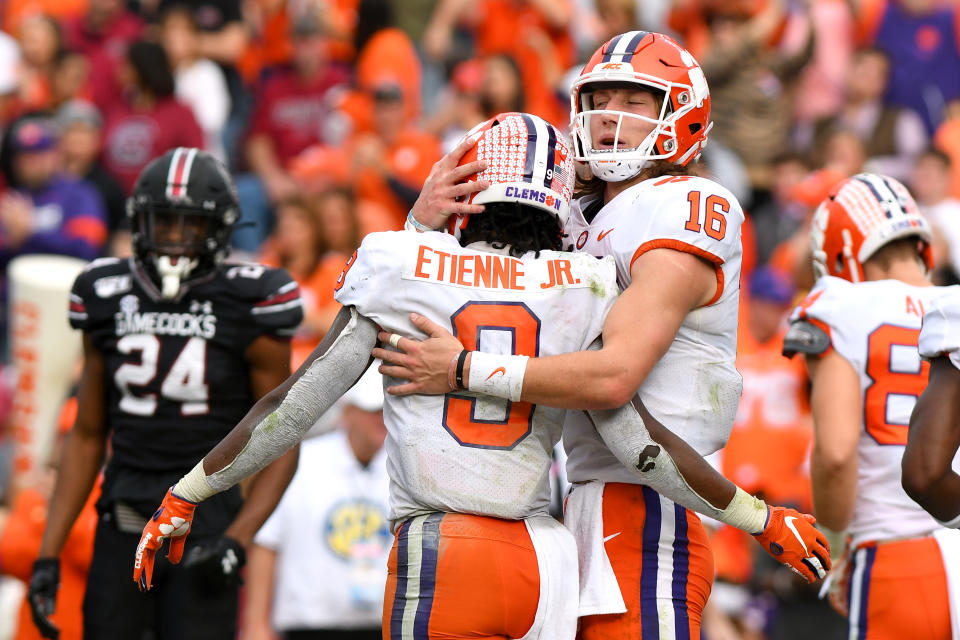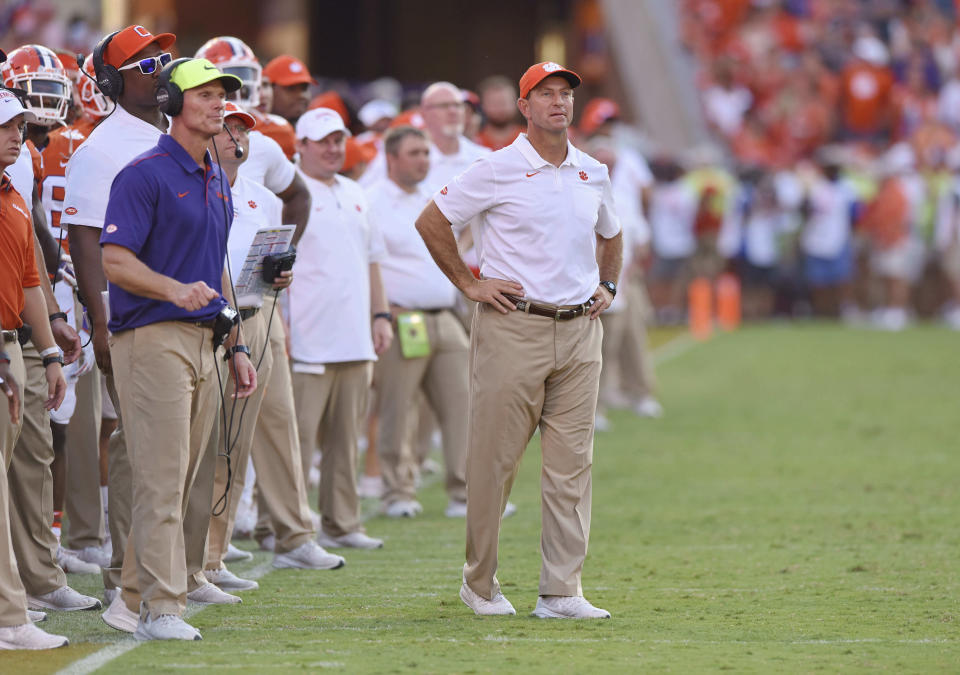Is Clemson really better than last season? Here are 4 key questions facing the Tigers
For years, Dabo Swinney has trotted out varying versions of his Little Ole Clemson trope. With his down-home accent and aw-shucks persona, Swinney has always clung to the familiar underdog role. As years passed and Clemson emerged as Big Ole Clemson – toppling Florida State for ACC supremacy and passing Alabama as the flagship national program – the remarks were easy to chuckle off as Dabo being Dabo.
This week, Swinney’s tenor changed a bit.
He went on a diatribe that reportedly lasted 25 minutes. He questioned narratives, pondered collective amnesia and said that ESPN provocateur Paul Finebaum “works for the SEC.”
While much of what Swinney complained about is difficult to quantify, this statement stood out: “This team is playing way better than last year’s team,” he said. “It’s not really close.”
That’s a bold statement, as last year’s team went 15-0, won its playoff games by an average of nearly four touchdowns and had three defensive linemen taken in the first round of the NFL draft.

Swinney’s comments struck at the great paradox of the 2019 football season: Has defending national champion Clemson (12-0), which is riding a 27-game winning streak, somehow been slighted? The Tigers have no victories over Top 25 opponents, but they have won their past seven games by an average of 41.7 points. The lack of competition has shaded their domination in relative anonymity, putting a veil of skepticism over their impressive results.
Yahoo Sports spoke to six coaches and assistants who’ve faced Clemson this year to figure out if this edition of the Tigers compared to last season’s iconic team that blasted Notre Dame and Alabama in the College Football Playoff by an average of nearly four touchdowns.
What’s wrong with Trevor Lawrence?
Well, nothing. That’s according to coaches on the defensive side of the ball who faced Lawrence this season.
“He’s got a cannon of an arm,” said one coach. “He looks like Zeus back there. He’s got a massive frame and can take shots. He’s the real deal.”
Lawrence has improved his completion percentage (68.6 from 65.2), yards per attempt (9.1 from 8.3) and already has matched his 30 touchdowns (Lawrence became a starter after the fourth game last season). His interceptions are up – eight compared to four – but so is the amount he’s been asked to do in the offense.
The more apt question to spin off the early season narrative surrounding Lawrence’s interception hiccups is whether he improved distinctly from last year. That’s tricky, multiple coaches said, because he likely authored the most impressive season for a freshman quarterback this generation.
One coach noted that Lawrence has improved going through his reads. (He was limited to mostly half-field reads last year.) Another said that he is more decisive in running the football, a clear progression from last year.
“The good ones don’t need to read the end, they just beat the end,” he said. “They read the defense pre-snap and determine if the defense is short a body in the box to run the ball. It’s a lot cleaner now, he’s not pulling it when he shouldn’t. He understands that part much better.”
A couple coaches mentioned being able to confuse Lawrence with exotic looks, which led to some of the interceptions. But the reason behind the early season bumps likely transcended schemes.
“I think Trevor forces things,” said another coach. “He can make all the throws. He tries to force things when he doesn’t have anything. I think he’s put too much pressure on himself. That’s forced him to make decisions he normally wouldn’t make.”

How has the defense evolved?
Clemson’s defense wasn’t going to have the heft of last season; five of their defensive linemen ended up playing in the NFL. In the offseason, Clemson defensive coordinator Brent Venables went to Iowa State and studied the three-down defense the Cyclones have been running under Jim Heacock. (Baylor also runs a similar scheme.)
“If they had the same war daddies up front, would they have changed their defense?” asked one opposing coach. “No way. If they had the same guys, there’s no need to change. Yeah, they do not have the same guys up front. They changed their defense. I thought it was a gutsy move that paid off big-time.”
Venables has always been versatile on defense. This year’s evolution comes with dabbling with three-down linemen, a light box and star hybrid defender Isaiah Simmons, who can perform at all three levels. What separates this defense is that Simmons can be an extra defensive back, linebacker or even a defensive lineman. Prior to the snap, you have no idea which role he’s going to take.
“It’s almost like they’re playing a box-and-1,” said one coach. “You don’t know where the hell he’s going to be all the time. Everything else is balanced and you can’t get a pre-snap read.”
This has become an effective way to neutralize run-pass-option plays. A different coach added: “Offenses haven’t adapted to that yet. What it does, it takes away a lot of RPOs. Coordinators aren’t patient enough to beat it.”
Much like Clemson’s season itself, the defensive adjustment by Venables has been unappreciated.
“It allows them to put their best players on the field and cause chaos,” said a coach. “It’s what they needed this year to make a run. Hats off to them, they could have won the ACC and finished somewhere between No. 5 and No. 12. But to get back to the Final Four they had to take a chance, and they did.”
Clemson is No. 2 in total defense (232.3) and No. 1 in scoring defense (10.1). Not bad, considering the talent dip.
What are Clemson’s weaknesses on defense?
The defensive front is the obvious place to start. Tiger stars Clelin Ferrell (drafted No. 4), Christian Wilkins (No. 13), Dexter Lawrence (No. 17) and Austin Bryant (No. 117) were all NFL picks last season. Reserve lineman Albert Huggins didn’t get drafted, but he got picked up by the New England Patriots this week. So, yes, there’s going to be natural drop-off.
“Their front is not nearly as good as last year,” said one coach.
The scheme change is an implicit acknowledgement of that. Clemson’s linebackers and safeties – outside of Simmons, who’ll be a first-round pick – aren’t dynamic playmakers. “There’s quite a few teams that have a better collection of linebackers and safeties,” said one coach. “They have some do-right guys.”
That’s a left-handed coach-speak compliment for sound players who do their duty within the scheme but don’t have the dynamism where they’ll be picked the first two days of the NFL draft.
“[Safety Tanner Muse] sticks out to me,” said a coach. “He’s a really good player and has made a lot of plays, but he’s a little bit stiff and you can get him in space and in the pass game and make some plays.”

What are Clemson’s weaknesses on offense?
There’s less to pick from here. There are two potential first-round picks at wide receiver in junior Tee Higgins (10 TDs) and sophomore Justyn Ross (seven TDs), looming 6-4 bookend nightmares. Travis Etienne won first-team All-ACC tailback, averaging 8.3 yards per carry.
Lawrence is still one of the three best players at his position in the sport, and NFL people haven’t moved his projection as the likely No. 1 pick in the 2021 NFL draft.
Where are the pimples on an offense that ranks No. 4 in scoring offense (45.3)? Clemson is pedestrian at tight end, as J.C. Chalk is the type of tight end that defenses can cover with a linebacker or defensive end and not worry about (compared to former Tigers tight end Jordan Leggett, for example).
Clemson has two potential answers for this. The first is that coaches who played Clemson later in the year noticed the Tigers played more 10 personnel – one running back, no tight end and four wide receivers – than early in the year.
“When they take [Chalk] off the field, they’re not hiding anymore,” one opposing coach said. “Last year, they only did that when they had to. It affects their run game and limits it, but good luck covering those [four receivers]. To me, they’re scarier when they do that.”
The other answer will come for Clemson in time for the College Football Playoff. Tight end Braden Galloway is considered a significant upgrade at tight end, and he comes off his year-long suspension for failing a drug test. How much Clemson integrates him will be an intriguing storyline heading into the College Football Playoff, assuming that Clemson can beat Virginia and win the ACC this weekend.
Where else can you probe? Blitzing is tricky, as the consensus was that Clemson has a better offensive line than last year and Lawrence gets the ball out lightning fast. The best chance on a blitz is to pick on Etienne.
“He’s not that good of a pass blocker,” he said. “He’s really your only chance. If they pick it up, he’s your only chance. You’re not running around the tackles. You may confuse them, but you’re not beating them.”
More from Yahoo Sports:
